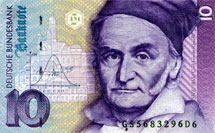

The German 10-Mark note (pre-Euro) featured Carl Friederich Gauß and his equation describing the “normal curve” of probability distribution.
Since about 1890, the study of statistics has reshaped much of social and natural science, along with important areas of medicine, business, engineering, policy and the law, without drawing much attention to itself. The public knows very little of the role of statistics, and even its practitioners are not accustomed to thinking of it as a historical force or as a product of history. There is by now a worthy body of scholarship on the history of statistics, written mainly by statisticians and historians of science, largely for an academic audience.
Theodore Porter, History, University of California, Los Angeles, review
of
The Lady Tasting Tea: How Statistics Revolutionized Science
in the Twentieth Century. David Salsburg. W. H. Freeman and
Co., 2001.
American Scientist Volume 89, No. 5 September-October 2001

